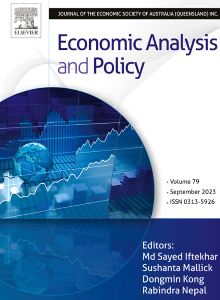The impact of climate policy uncertainty on tail risk of energy companies: Evidence from China
IF 8.7
2区 经济学
Q1 ECONOMICS
引用次数: 0
Abstract
Against the backdrop of the accelerated advancement of the "dual-carbon" goals, climate policy uncertainty (CPU) has emerged as a critical driver behind the evolution of extreme risks for energy enterprises. Accurately identifying its operational mechanisms holds significant strategic importance for safeguarding national energy security and facilitating green transformation. To unravel the intrinsic mechanisms and potential impacts through which CPU exacerbates extreme risks for energy enterprises, this study employs a two-way fixed effects model to systematically evaluate the pathways through which CPU affects the tail risks of energy enterprises, thereby providing a basis for risk early warning. Using Chinese energy-listed companies as the sample, with data spanning from April 2010 to December 2022, this paper measures the level of tail risks by applying the GARCH-VaR model. The findings reveal that CPU induces extreme risks for enterprises and significantly elevates their tail risk levels. Mechanism tests indicate that CPU increases enterprises' tail risks by undermining investor confidence and constraining corporate green innovation. Furthermore, the partial mediating role played by the level of corporate green innovation exhibits a "suppression effect." In addition, non-state-owned enterprises and those with high analyst attention are more vulnerable to the impact of CPU in terms of tail risks. There are also significant regional disparities in the impact of CPU on the tail risks of energy enterprises across eastern, central, and western China. The results of this study provide certain policy implications for addressing the impact of CPU and preventing extreme losses.
气候政策不确定性对能源企业尾部风险的影响:来自中国的证据
在“双碳”目标加速推进的背景下,气候政策不确定性已成为能源企业极端风险演变的关键驱动因素。准确定位其运行机制,对于维护国家能源安全和促进绿色转型具有重要战略意义。为揭示CPU加剧能源企业极端风险的内在机制和潜在影响,本研究采用双向固定效应模型,系统评价CPU影响能源企业尾部风险的路径,为风险预警提供依据。本文以中国能源上市公司为样本,选取2010年4月至2022年12月的数据,运用GARCH-VaR模型对尾部风险水平进行测度。研究发现,CPU会给企业带来极端风险,并显著提高企业的尾部风险水平。机制检验表明,CPU通过削弱投资者信心和制约企业绿色创新来增加企业尾部风险。企业绿色创新水平的部分中介作用呈现“抑制效应”。此外,在尾部风险方面,非国有企业和分析师关注度较高的企业更容易受到CPU的影响。CPU对能源企业尾部风险的影响在东、中、西部地区也存在显著的区域差异。本研究结果为解决CPU的影响和防止极端损失提供了一定的政策启示。
本文章由计算机程序翻译,如有差异,请以英文原文为准。
求助全文
约1分钟内获得全文
求助全文
来源期刊

Economic Analysis and Policy
ECONOMICS-
CiteScore
9.80
自引率
9.20%
发文量
231
审稿时长
93 days
期刊介绍:
Economic Analysis and Policy (established 1970) publishes articles from all branches of economics with a particular focus on research, theoretical and applied, which has strong policy relevance. The journal also publishes survey articles and empirical replications on key policy issues. Authors are expected to highlight the main insights in a non-technical introduction and in the conclusion.
 求助内容:
求助内容: 应助结果提醒方式:
应助结果提醒方式:


